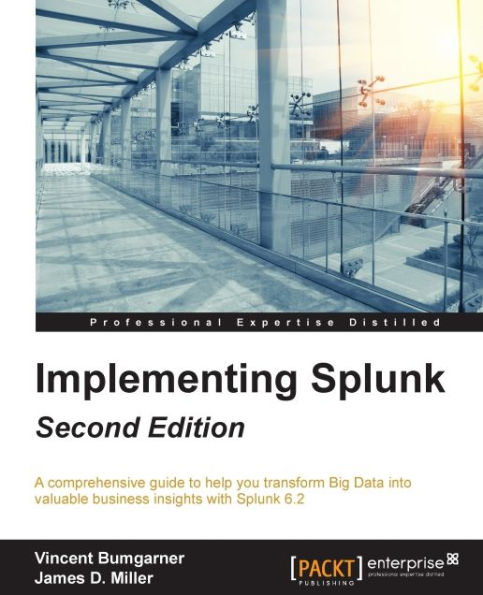- Learn to search, configure, and deploy Splunk on one or more machines
- Start working with Splunk fast, with a tested set of practical examples and useful advice
- Step-by-step instructions and examples with comprehensive coverage for Splunk veterans and newbies alike
If you are a data analyst with basic knowledge of Big Data analysis but no knowledge of Splunk, then this book will help you get started with Splunk. The book assumes that you have access to a copy of Splunk, ideally not in production, and many examples also assume you have administrator rights.
- Enrich your data with lookups and commands
- Transform your data into useful and beautiful reports
- Build professional-looking, informative dashboards
- Get to know what Splunk data models and pivots are
- Learn about pivot editor, pivot elements, filters, Sparklines, and more
- Manage configurations from one to thousands of instances
- Extend Splunk with scripts and advanced configuration
- Create fields from your unstructured data
- Write searches that are fast and lean
Splunk is a type of analysis and reporting software for analyzing machine-generated Big Data. It captures, indexes, and correlates real-time data in a searchable repository from which it can generate graphs, reports, alerts, dashboards, and visualizations. It aims to make machine data accessible across an organization for a variety of purposes.
Implementing Splunk Second Edition is a learning guide that introduces you to all the latest features and improvements of Splunk 6.2. The book starts by introducing you to various concepts such as charting, reporting, clustering, and visualization. Every chapter is dedicated to enhancing your knowledge of a specific concept, including data models and pivots, speeding up your queries, backfilling, data replication, and so on. By the end of the book, you'll have a very good understanding of Splunk and be able to perform efficient data analysis.
- Learn to search, configure, and deploy Splunk on one or more machines
- Start working with Splunk fast, with a tested set of practical examples and useful advice
- Step-by-step instructions and examples with comprehensive coverage for Splunk veterans and newbies alike
If you are a data analyst with basic knowledge of Big Data analysis but no knowledge of Splunk, then this book will help you get started with Splunk. The book assumes that you have access to a copy of Splunk, ideally not in production, and many examples also assume you have administrator rights.
- Enrich your data with lookups and commands
- Transform your data into useful and beautiful reports
- Build professional-looking, informative dashboards
- Get to know what Splunk data models and pivots are
- Learn about pivot editor, pivot elements, filters, Sparklines, and more
- Manage configurations from one to thousands of instances
- Extend Splunk with scripts and advanced configuration
- Create fields from your unstructured data
- Write searches that are fast and lean
Splunk is a type of analysis and reporting software for analyzing machine-generated Big Data. It captures, indexes, and correlates real-time data in a searchable repository from which it can generate graphs, reports, alerts, dashboards, and visualizations. It aims to make machine data accessible across an organization for a variety of purposes.
Implementing Splunk Second Edition is a learning guide that introduces you to all the latest features and improvements of Splunk 6.2. The book starts by introducing you to various concepts such as charting, reporting, clustering, and visualization. Every chapter is dedicated to enhancing your knowledge of a specific concept, including data models and pivots, speeding up your queries, backfilling, data replication, and so on. By the end of the book, you'll have a very good understanding of Splunk and be able to perform efficient data analysis.

Implementing Splunk - Second Edition
506
Implementing Splunk - Second Edition
506
Product Details
| ISBN-13: | 9781784399306 |
|---|---|
| Publisher: | Packt Publishing |
| Publication date: | 07/28/2015 |
| Sold by: | Barnes & Noble |
| Format: | eBook |
| Pages: | 506 |
| File size: | 25 MB |
| Note: | This product may take a few minutes to download. |
